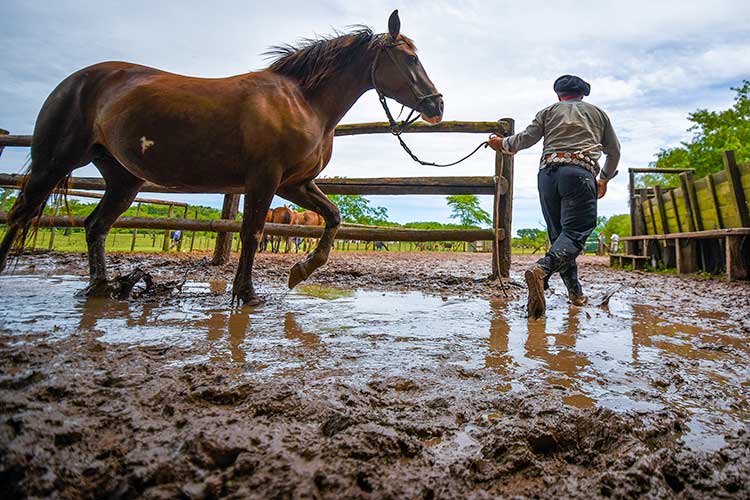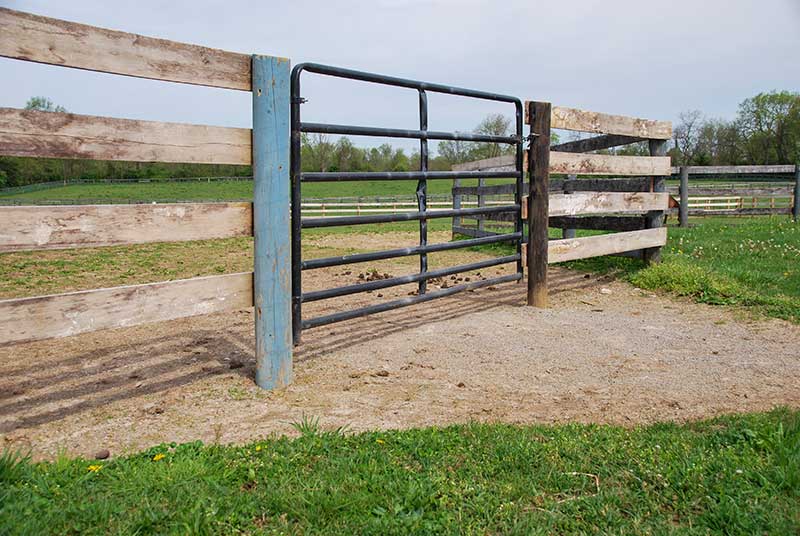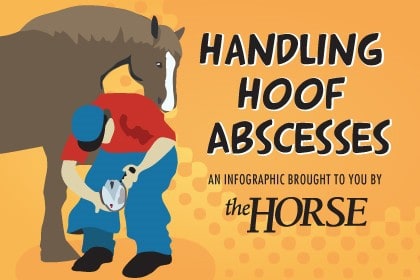Fighting Foot Funk
- Topics: Abscesses, Hoof Care, Hoof Problems, Horse Care, Thrush, White Line Disease

How to combat foot issues such as thrush, white line disease, and abscesses that can develop in or be exacerbated by moist, muddy conditions
Mud is one of the worst enemies of hoof health. While equine feet need moisture to prevent cracking and chipping, they can become too soft in wet environments. Feet that are continually soft and moist tend to lose their structural integrity—becoming vulnerable to conditions such as thrush, white line disease, and abscesses. In this article we’ll explain how to prevent and manage these common springtime issues.
Step 1: Minimize Mud
Leah Ellis, DVM, an internal medicine resident at the University of Prince Edward Island’s Atlantic Veterinary College, in Canada, practices in a region that gets a lot of rain.
“We have a long season of mud,” she says. Ellis has a particular interest in hoof health and recently published a case study about white line disease. “I try to help horse owners manage and plan to minimize mud problems, including ways to feed horses in paddocks. If you can situate or plan a paddock with uphill areas that are well-drained, this is where you could put the round bale or hay feeder, so that when horses are eating they are standing on ground that is drier than the rest of the paddock. Once every year or two you could add a gravel pack on that uphill area so it will continue to drain well.”
Other areas where horses spend significant time, such as by water sources or the gate, might also need a rock and gravel base.
“We want to ensure that the areas where they spend time are not the swampiest parts of the paddock,” says Ellis. “You can plan ahead regarding which paddock you might use during the wettest parts of the year to avoid overusing and beating up the paddocks that have grass.”
Owners who take a break from riding in winter often think they can pull their horses’ shoes and save money at farrier visits, but bare feet that aren’t properly maintained can get chipped and damaged easily, making it easier for hoof diseases to gain a foothold. Further, wet or muddy footing might compromise hoof integrity more easily.

Travis Burns, MSc, CJF, TE, EE, FWCF, chief of farrier services at the Virginia-Maryland Regional College of Veterinary Medicine, in Blacksburg, Virginia, explains why. “The foot expands when soft and may give microbes opportunity to invade,” he says. “Mud also predispose horses to shoe loss.”
A soft hoof doesn’t hold nails well, and deep mud can impair a horse’s normal way of traveling. He might step on one shoe with another foot and pull it off. This can be a perpetual vicious cycle: If the horse loses a shoe—especially if he pulls it off forcefully, taking some of the hoof wall with it—it can be difficult to nail back on. Those defects also make it much easier for microbes such as bacteria and fungi to invade.
If a farm has wet, muddy conditions, Burns suggests reaching out to the local extension office for advice on drainage and ways to improve footing. Installing a geotextile “high-traffic” pad over a rock base that allows drainage can greatly reduce mud issues.
The Importance of Regular Hoof Care
“Even if you are constantly fighting mud and think you are losing the battle, the best way to mitigate this problem is with good hoof care and frequent attention from your farrier,” says Ellis. This can help ensure feet have the best integrity possible, even in undesirable conditions.
Feet affected by the additional forces a long toe creates, for instance, or any uneven stresses on the hoof, are more vulnerable to white line disease. Those sheer forces weaken and separate the hoof from the sole and allow moisture, foreign materials, and microbes deeper into the hoof.
“Frequent farrier care will help you stay on top of these things, making sure the hoof breakover stays easy and toes are not overgrown,” says Ellis. “Mud plus a neglected foot often turns into a problem. If we can keep the horse’s environment cleaner and drier and pick out the feet daily, we may be able to prevent trouble.”
With this attentiveness, horse owners might be more likely to notice the start of a problem.
When problems do arise, early treatment is best, says Lydia Mudd, DVM, a certified farrier through the American Farrier’s Association and an equine veterinarian at Janssen Veterinary Clinic, in Sheridan, Indiana. “Most farriers are good at catching small areas of white line disease or abnormal pockets of thrush that are just getting started,” she says. “If your farrier tells you he/she is worried about a certain situation, take that to heart and continue to do whatever treatment is advised between farrier visits.”
If the farrier tells you something has gone beyond what he or she is comfortable treating, it’s wise to also involve your veterinarian. He or she might need to intervene and/or take radiographs to determine the extent of the problem. “The more aggressive you can be early on, the more likely you can prevent it from becoming something that will cause discomfort to the horse or need long-term treatment to resolve,” says Mudd.
Abscesses
“Subsolar abscesses are the No. 1 cause of lameness in horses,” says Burns. These are caused by microbes that invade through the white line or any other compromised areas. When they get into dermal structures, they can create a closed-cavity infection. The subsequent swelling and inflammation can be very painful.

“Nine times out of 10 these will be just run-of-the-mill abscesses that can be easily resolved, but sometimes there are additional issues,” says Mudd. “Abscesses … may happen slowly through tiny cracks in the wall or sole or suddenly if the horse steps on something that causes a penetrating injury. Sometimes a serious bruise may be the start of an abscess.”
If your veterinarian or farrier finds the pocket of infection, he or she can drain it. Then you must protect that area—as well as possible—from getting packed with dirt/mud and debris.
Burns says the best thing you can do is keep your horse in a dry environment and keep the abscess clean, dry, and bandaged. “Even if you drain the abscess and get it healing, if you put the horse back into wet, muddy conditions, it will likely recur or seal over and create a new abscess,” he says.
After healing, the hoof horn in the cavity needs to grow and might require protection in the meantime. “It can be covered with a shoe and a pad to protect it long-term until the hoof grows out,” says Burns, and the defect can be trimmed away. How long this takes depends on where the abscess was located and where it drained from.
Even if your horse has gone unshod in the past, your farrier might recommend a protective pad and shoe. “There are many different types of packing materials to place between the hoof and the pad, including medication options that prevent growth of microbes,” says Mudd.
She tells owners to think of a shoe and pad like a bandage you can conveniently leave on for a shoeing cycle. “Instead of the owner having to be at the barn every day changing a bandage for the next five weeks, the shoe and pad will keep that fragile, compromised area protected from potentially abscessing again,” she says.
Susceptibility to Hoof Infections
Some horses seem more prone to thrush, white line disease, or hoof abscesses than others, possibly due to genetics or conformation. Some individuals have stronger hoof walls and thicker soles, while others have weaker, thinner structures. Some breeds tend to have tougher, more robust feet overall.
“If horses have conformational faults that cause them to overload a portion of the foot, there is more stress on those parts (and more likelihood for separations), and the hoof is also more likely to deform if it is soft,” says Lydia Mudd, DVM, a certified farrier through the AFA and an equine veterinarian at Janssen Veterinary Clinic, in Sheridan, Indiana. “This may allow microbes access, especially if there is already an overloaded or weakened spot in that hoof.”
Health status also plays a role. “Are the horses on an appropriate diet? Do they have any other health issues like PPID (pituitary pars intermedia dysfunction) or metabolic disease? Are they battling any systemic illness? Overall health can have a huge effect on hoof wall quality,” she says. “Also, is there any history of other hoof diseases that might change how the hoof wall grows? Laminitis, for instance, can compromise long-term hoof integrity, as can injury to the coronary band that causes abnormal hoof growth.”
Hoof structure is like building structure. “If the outside of your house is solid and has never had a problem, it will be more resistant to water damage, earthquakes, or other forces,” Mudd explains. “But if a tree fell on it last year and the damage was never fully repaired, it may not withstand further problems.
“You can’t always tell whether a certain horse’s feet will have problems,” she continues. “And some owners just want a magic supplement or topical medication that will fix a problem when the most important thing is trying to fix the environment, if possible—along with putting in the daily time and effort to keep the feet clean.”
—Heather Smith Thomas
White Line Disease
Alternately wet-dry environments can lead to white line disease, which usually starts at the bottom of the foot and travels upward as anaerobic (thrives without oxygen) hoof-digesting microbes hollow out the area.
“White line disease affects the nonpigmented stratum medium of the hoof wall (the zone between the outer and inner hoof wall) and not necessarily the white line on the bottom of the foot,” Burns explains.
You might not notice it until a large area is damaged, which necessitates drastic action and treatment. Prevention—and early intervention—can save a lot of time, expense, and horse discomfort.
Farriers often first notice the problem during routine trimming. They might remove the dirt/debris along the white line with a hoof knife, revealing an undermined area filled with powdery material.
“There may be rather large areas of separation inside a normal-looking hoof wall,” says Burns. “The treatment I prefer is debridement to cut away all the damaged/diseased area. It should be cleaned out until there’s a healthy-appearing margin. This exposes it (and the microbes within) to UV light and oxygen.
“After the area is debrided and clean, it can be treated topically with a number of antiseptic products,” he continues. “If the area is not debrided sufficiently, however, you are wasting your efforts because the disease process will continue. You can’t put anything topical on an area that hasn’t been debrided and expect it to work.
“After that, the owner/trainer should pick out the feet (once) daily, brush them, and do everything possible to get them clean, and then apply topical medication,” he continues. “The oxygen and UV light do most of the work in clearing the infection; the topical treatment simply attacks the last hidden remaining microbes.”
Even though some horses seem more predisposed to white line disease than others, Burns says there’s no doubt it’s an environmental phenomenon. “You need to provide as clean and dry an environment for the foot as you can,” he says. “It’s also important to minimize change from wet to dry to wet.” Going continually from a wet foot to a dry foot is hard on the hoof wall and sole and leaves it vulnerable.
“White line cases can become severe enough to destabilize the entire hoof,” says Mudd. “Then the horse must be rested for several months during recovery. If you can catch that problem a bit earlier, the treatment is a lot cheaper and easier.”
Thrush
Thrush is another disease in which microbes degrade and weaken keratinized (insensitive) hoof tissue, though thrush specifically affects the frog. Fungi and bacteria attack the sulci (clefts alongside the frog) and sometimes deeper tissues near the frog, causing a foul-smelling infection. The most common culprit is Fusobacterium necrophorum.
“Similar to white line disease, microbes that cause thrush love wet, unhygienic, anaerobic environments,” says Mudd. A foot that’s always packed with mud and manure provides the ideal airless, moist environment for thrush. Just picking the feet out daily, exposing those tissues to air, and keeping the horse in a dry, clean environment can go a long way toward preventing disease.
If you live in a place prone to mud and moisture, exercise the horse regularly to dry out the feet and encourage proper blood circulation. Flexing of the foot at each step, expanding and contracting as the horse travels, enables lodged material to fall out.
Proper farrier care also helps prevent thrush. An unbalanced foot or one with contracted heels and deep clefts alongside the frog, where mud/manure can pack in, is at greater risk of developing thrush. Keeping the frog trimmed of ragged, loose tags also helps the sulci self-clean so they don’t collect debris as readily.
If a horse starts to develop thrush, treatment with iodine or a commercial thrush product might help clear it up, especially if you also move the horse to clean, dry conditions. If the horse must stay in a muddy paddock during wet seasons, however, it might take daily care to correct and prevent thrush.
“Keeping the hoof clean and dry is important, rather than just using various hoof-strengthening paints and topical products,” Ellis says. “Sometimes those just seal in moisture and make the foot more likely to have problems.”
Take-Home Message
Mud and moisture can soften and impair the hoof’s structural integrity, making it vulnerable to hoof infections like thrush, white line disease, and abscesses. It’s important to find ways to minimize mud in horse pens and improve footing. Diligent, regular hoof care can help prevent some issues, as well as enable owners and farriers to discover—and deal with—problems early, before they become serious.
Written by:
Heather Smith Thomas
Related Articles
Stay on top of the most recent Horse Health news with












